
About Handball
Handball is a fast-paced team sport played between two teams. Each team comprises seven players, six of them are outfield players, and one of them is the goalkeeper. It is not mandatory to have a goalkeeper, and they can be substituted, by an outfield player based on the team’s strategy.
The players of this sport are very agile and energetic making it a fast-paced game. Players use their hands to dribble and throw the ball into the opposing team’s net scoring a goal.
The team scoring the maximum number of goals in the allotted time wins the game. The players are always on the lookout to score a goal by passing the ball, among their team members. This sport is full of action and speed.
Handball is played, as an indoor sport in all the major tournaments. The team that has possession of the ball that tries to score a goal is said to be offensive, while the other team defending the opponents to score are defensive.
Handball is played by both men and women as a separate event. The men’s handball was first introduced at the Berlin Olympics in 1936 as an outdoor event. The sport was dropped from the Olympics and re-entered at the Munich Olympics of 1972. Women’s handball was introduced later at the Montreal Olympics in 1976.
International Handball Federation (IHF) formed in 1946, is the governing body of this sport. They set the rules of the sport and organise competitions around the world.
Handball Olympic 2020 logo : ![]()
History
This sport has ancient roots and was a popular sporting event amongst Romans. Ancient paintings and wall carving depict the love of this sport.
The modern team handball started in Denmark. The rules related to it were documented by a Danish physical education teacher. The modern set of rules was published on 29 October 1917 by Max Heiser, and the sport soon gained popularity.
The sport is played at a fast pace, and that thrilled the audience as there is never a dull moment in the sport as each team tries to outperform another team by scoring the maximum number of goals.
The men’s handball was first introduced at the Berlin Olympics in 1936 as an outdoor event. The sport was dropped from the Olympics and re-entered at the Munich Olympics of 1972. Women’s handball was introduced later at the Montreal Olympics in 1976.
Objective
The objective of handball is to score more goals than your opponent in the stipulated time. The team scoring the maximum number of goals wins the game.
The duration of the game is 60 minutes and divided into two halves each of 30 minutes duration. A 15 minutes break to divide, the first half from the second half.
If a game ends up in a tie, two five-minutes extra time is allocated to the teams. In case of a tie after the extra time, a shootout determines the winner of the match.
Handball Court
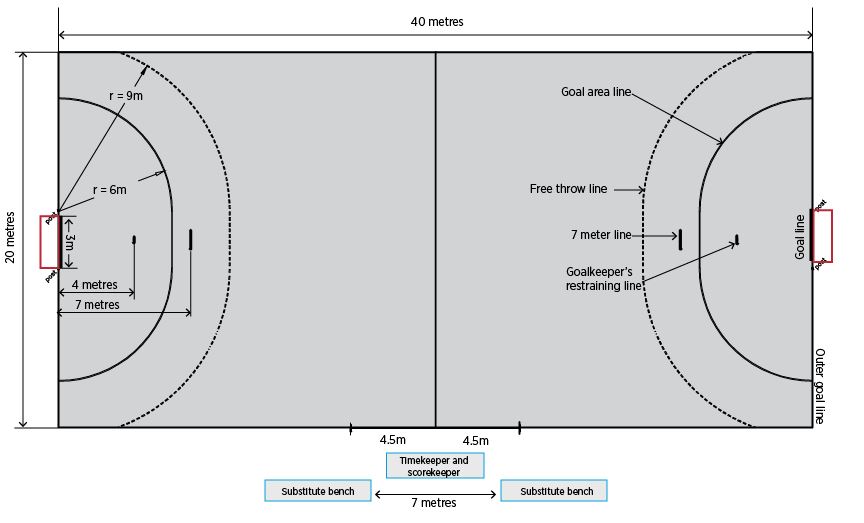
The handball court has a length of 40m and a width of 20m. Goals are situated at the middle of each end. A centre line divides the court into two halves of 20m each.
A D-shaped line of length 6m is drawn from the goal known as the goal crease, and a player cannot shoot the ball from inside this crease. The goalkeeper can touch the ball with feet or hands within this perimeter of the goal crease.
A dotted free throw line is drawn about 9m from the goal and 3m from the goal crease and has a marking at the 7m from the goal used for the shootout.
On the long edge of the court to both sides of the middle line are the substitution areas for each team of 9m extending 4.5m on each side. A team’s substitution area is on the same side the team is playing defending. Any player leaving or entering the field must do so from the substitution area.
How The Sport Is Played
The game starts with a toss of a coin, where the winner selects either side or the starting throw. The game starts with the referee signal from the centreline. After each goal, the ball is brought to the centreline and the game is started by the team conceding the goal.
The player can dribble the ball or pass it to their teammates, a player is neither allowed to hold a ball for more than three seconds after dribble nor they are allowed to carry the ball with them for more than three steps holding the ball. Any violation of these rules results in a penalty where a free throw gets awarded to the other team.
Players of the team must make a conscious effort to score a goal, if the referee finds that players are not making conscious efforts to shoot the ball towards the goal a “Passive Play” is called by the referee and a free throw is awarded to the opponent team.
The opposing team tries to defend the offensive team by blocking the ball or forming a defensive wall preventing them to shoot. A defender has to be careful not to jump into an offensive player. They cannot snatch the ball from the offensive player’s hand.
Any infraction results in awarding of a free throw to the other team. But the defensive players are allowed to make bodily contact with the offensive team members in the pursuit of the ball.
There are strict rules for scoring a goal. The offensive player cannot shoot the ball from inside the goal crease. The player can be airborne shooting the ball before landing inside the goal crease.
The goal is disallowed if a player shoots from inside the goal crease. The ball must cross the goal line for the goal to be counted.
A goalkeeper can touch the ball with their feet only when inside the goal crease for preventing the goal. The goal crease is the exclusive perimeter of the goalkeeper, if a defender steps into the goal crease to prevent an offensive player from shooting, they are penalised by a seven-meter throw is awarded by the referee.
The goalkeeper can act as a player outside the goal crease. All the restrictions for a player apply to the goalkeeper in that case.
Handball is a fast-paced game, and hence it is monitored by two referees with similar authority. The referee can overlap with the other half if any violation of rules catches their eyes.
There is no restriction on substitution, and a player can be substituted anytime during the match. A goalkeeper can be substituted with a court player by the coach depending upon the match situation. In such a case, the goal remains unprotected, and the opposition can score the goal easily.
The substitution should take place from the restricted area marked for substitution. Substitution of a player from any other area invokes strict penalties.
At the end of stipulated time the team scoring the maximum goals wins the match.
Terms Associated
The terms associated with Handball.
Throw Off: A throw off always takes place from the centre of the court. A player must touch the centre line with one foot and throws the ball to the teammates. This takes place at the start of each half of the game and upon scoring a goal.
Goalkeeper Throw: When the ball goes outside the goal area due to an inaccurate throw by the offensive team or a deflection from the defending goalkeeper. The goalkeeper can throw the ball from the goal area.
Throw In: A throw-in is awarded to the opposing team when a player of the team is the last to touch the ball that has gone outside the sidelines. If the last touched player is the goalkeeper, and the ball goes outside the goalpost then no throw-in is awarded to the opposition team.
Seven-meter Throw: This throw is awarded by the referee when a clear chance of scoring is illegally prevented by a defender. This throw should be taken within three seconds from the signal of the referee.
Free Throw: This throw is awarded by the referee to start the game due to some interruption that happened during the match. This throw is awarded from the same spot where the interruption occurs.
Timeout: A team can call 3 timeouts per game having a duration of one minute each. The timeout can be called by the team official only when the ball is in the possession of their team. They display a green card marked with the letter ‘T’ to the timekeeper. The timekeeper blows a sound and stops the time clock.
The timeout can also be called by referees due to any injury suffered by a player or mopping up the dust or sweat in the court.
Fouls And Penalties
Fouls are commited by players and penalties imposed by referees.
In case of an illegal tackle such as tripping, pushing, holding or jumping, the player is shown a yellow card that serves as a warning card. A second foul by the same player leads to a two-minute suspension from the game.
The referee can directly impose a two-minute suspension on a player if the tackle is serious like striking the player in the neck or throat.
If the same player commits the foul again, a second two min suspension is awarded to the player and shown a yellow card.
If the same player commits the foul again for the fourth time, the player can be shown a red card and ejected from the match. This is called progressive foul.
A referee can award a direct red card to a player and eject it from the match if the tackle or the foul committed by the player is serious.
In handball, the coach and supporting staff can also be penalised progressively. If a two-minute suspension is awarded to them, the coach must take one player away for two min, though that player has not committed the foul. This makes handball a complete team sport.
Whenever the referee calls a foul, the player in the current possession of the ball should lay the ball to the ground or can risk a two-minute suspension from the referee. Arguing with the referee over a decision or displaying decent can also attract a two-minute suspension from the game.
Handball Equipments
Handball: Handballs are either made from leather or made from synthetic fibre. The ball should not be shiny or slippery as it needs to be caught by a single hand by the player.
For mens, the circumference of the ball is 60 cm weighing 475 gm. For women, the circumference of the ball is 56 cm weighing 375 gm.
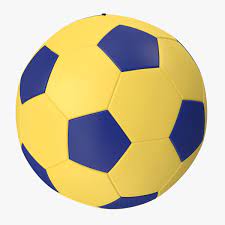
Goal Post: Goalposts are located at the width of two ends. Each goal post has a length of 3m and a height of 2m. The goalposts are made of wood. A goal net covers the back of the post, that shields the ball going through it.
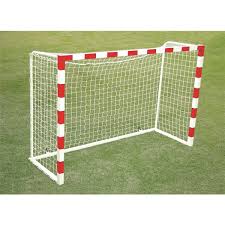
Protective Gears: Though it is not mandatory to wear protective gears, players can wear knee guards and elbow guards and teeth-guard.
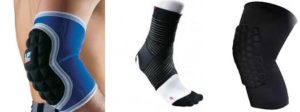
Dressing Code: Each player should be wearing the team jersey. There should be no provocative message in the jersey that dampens the spirit of the game.
Shoes: Shoes with rubber soles are preferred by the players for increased grip that prevents skidding.
Handball Officials
Referees: Two referees manage a handball match. They possess equal capabilities and position themselves in such a way that they can keep an eye on the entire match. In case of disagreements between the referees, a short discussion can happen to reach a mutual agreement. They use hand signals for any foul or goal throw. The judgement of referees is final during a match.
Scorekeeper: The scorekeeper is responsible for maintaining the scores of the teams. The scoring of a goal is only counted if the ball crosses the goal line. They are also responsible for keeping an eye on the substitution. Any violation of substitution rules is reported to the referee.
Timekeeper: The timekeeper is responsible for maintaining the time duration of the match. They stop the time in case of any timeout and restart the clock after completion of one-minute duration. They are the ones responsible for team timeout notification to referees.
Game Positions
Handball is a fast-paced game, and the player’s interchange their positions among themselves to have a better scoring opportunity.
There are seven players on the court at any time of the handball unless a player has been displayed a yellow card or provided with a two-minute penalty.
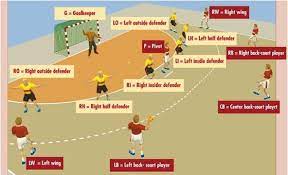
Goalkeeper: The goalkeeper’s position is the most crucial in a handball match. Within the goal crease perimeter, they act as a goalkeeper when outside the perimeter they act like a normal player. They are allowed to deflect the ball using their legs within the goal crease perimeter. They cannot do so once outside the goal crease.
When a ball goes outside the goal line after deflecting the goalkeeper, the goalkeeper retains possession of the ball and re-starts the match with a goalkeeper throw.
Left and Right Back: They are the most physical and tall members of the team, as they need to block or tackle the attacking team players. They also should have the ability to jump high to block the ball. They possess the skills to take long-range shots.
Left and Right-Wingers: They position themselves at the extreme side of the court. The left-wingers should be right-handed, and the right-wingers should be left-handed to land an accurate throw into the goal. They are also able and wide jumpers and always lookout for a better angle to take a shot. While defending, they try to narrow the shooting angles of the offensive team members.
Centre Back: This position is occupied, by the most experienced member of the team. They guide and indicate the other team members to be in the right positions. They possess a creative and attacking mind always for a lookout to a player that has a good chance of scoring. They are also good blockers.
Centre Forward: The player of this position plays a pivotal role. They distract the defensive players by running around them. They are experts in exploiting gaps in the defence, receiving and delivering the ball to the player most suitable to score a goal. They are the most agile member of the team, constantly moving and distracting the defensive players.
Rules Of Sport
- The players are not allowed to wear any sharp objects that can harm other players or cause an injury.
- Only goalkeepers are allowed to come in contact with the floor of the goal area.
- Outfield players are allowed to touch the ball with any part of their body above their knee.
- Disqualified or ejected team members or officials should leave the arena immediately and should not have contact with the team.
- The game is played in two halves of 30 min duration with a 15 min break. Three timeouts of one min duration are allowed per team within the entire play.
- Timeout can be called by referees anytime due to an injury or mopping up the floor.
- The players should respect the spirit of the game and upheld the same. They should not involve in any activity dampening the spirit of the game.
- The game is played with 7 members of a team on both sides. Entry of any additional player in the playing arena is entitled to a two-minute penalty.
- When a player stops dribbling, they may only take three steps and must pass the ball within three seconds.
- The players are allowed to protect their joints like knee or ankles with protective non-metallic gear that should not have sharp ends.
- The team scoring the maximum number of goals within the allocated time wins the match. Two five minutes additional times are played in case of a tie. Shootouts from the 7m throw line result after that to identify a clear winner.
- The ball should entirely cross the goal line to be considered a valid goal.
World Rankings
- Mens Handball Rankings
- Denmark

- Norway

- France
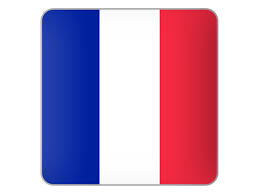
- Womens Handball Rankings
- Netherland

- Spain

- Russia





 (2 votes, average: 5.00 out of 5)
(2 votes, average: 5.00 out of 5)


